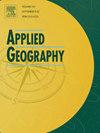意大利的环境正义:揭示受污染地区的社会人口劣势
IF 4
2区 地球科学
Q1 GEOGRAPHY
引用次数: 0
摘要
本研究通过分配视角考察了意大利的环境不公,重点关注被指定为国家利益遗址(SNIs)的污染地区。采用空间重合法和基于Mazziotta-Pareto指数的复合指标,对2021年人口普查数据进行分析,探讨社会人口劣势与环境污染之间的重叠关系。通过关注sni的法律定义边界,本研究增强了我们对环境风险如何与人口脆弱性概况相交的理解。我们的研究结果表明,SNI地区往往比非SNI地区具有更高的社会人口劣势,尽管SNI地区之间存在相当大的差异,反映了历史、地理和社会经济背景的差异。劣势的组成部分是多方面的,并且没有清晰、易于解释的模式出现在所有的sni中。这些发现提供了对意大利环境正义研究中使用的理论和方法框架的批判性反思。我们主张超越纯粹的分配方法,调查脆弱社区过度暴露于环境危害的机制和过程。此外,我们强调了用本地化案例研究补充国家层面研究的重要性,以更好地捕捉环境不公正的具体动态。本文章由计算机程序翻译,如有差异,请以英文原文为准。
Environmental justice in Italy: unravelling the socio-demographic disadvantage in contaminated areas
This study examines environmental injustice in Italy through a distributive lens, focusing on contaminated areas designated as Sites of National Interest (SNIs). Using the spatial coincidence method and a composite indicator based on the Mazziotta-Pareto Index, we analyzed 2021 census data to explore the overlap between socio-demographic disadvantage and environmental contamination. By focusing on the legally defined boundaries of SNIs, this research enhances our understanding of how environmental risk intersects with population vulnerability profiles. Our results reveal that SNI areas tend to have higher levels of socio-demographic disadvantage than non-SNI areas, although there is considerable variability across SNIs, reflecting differences in historical, geographical and socio-economic contexts. The components of disadvantage are multifaceted, and no clear, easily interpretable pattern emerges across all SNIs. These findings provide a critical reflection on the theoretical and methodological frameworks used in environmental justice research in Italy. We argue for moving beyond a purely distributive approach to investigate the mechanisms and processes underlying the disproportionate exposure of vulnerable communities to environmental hazards. Additionally, we highlight the importance of complementing national-level studies with localized case studies to better capture the specific dynamics of environmental injustice.
求助全文
通过发布文献求助,成功后即可免费获取论文全文。
去求助
来源期刊

Applied Geography
GEOGRAPHY-
CiteScore
8.00
自引率
2.00%
发文量
134
期刊介绍:
Applied Geography is a journal devoted to the publication of research which utilizes geographic approaches (human, physical, nature-society and GIScience) to resolve human problems that have a spatial dimension. These problems may be related to the assessment, management and allocation of the world physical and/or human resources. The underlying rationale of the journal is that only through a clear understanding of the relevant societal, physical, and coupled natural-humans systems can we resolve such problems. Papers are invited on any theme involving the application of geographical theory and methodology in the resolution of human problems.
 求助内容:
求助内容: 应助结果提醒方式:
应助结果提醒方式:


